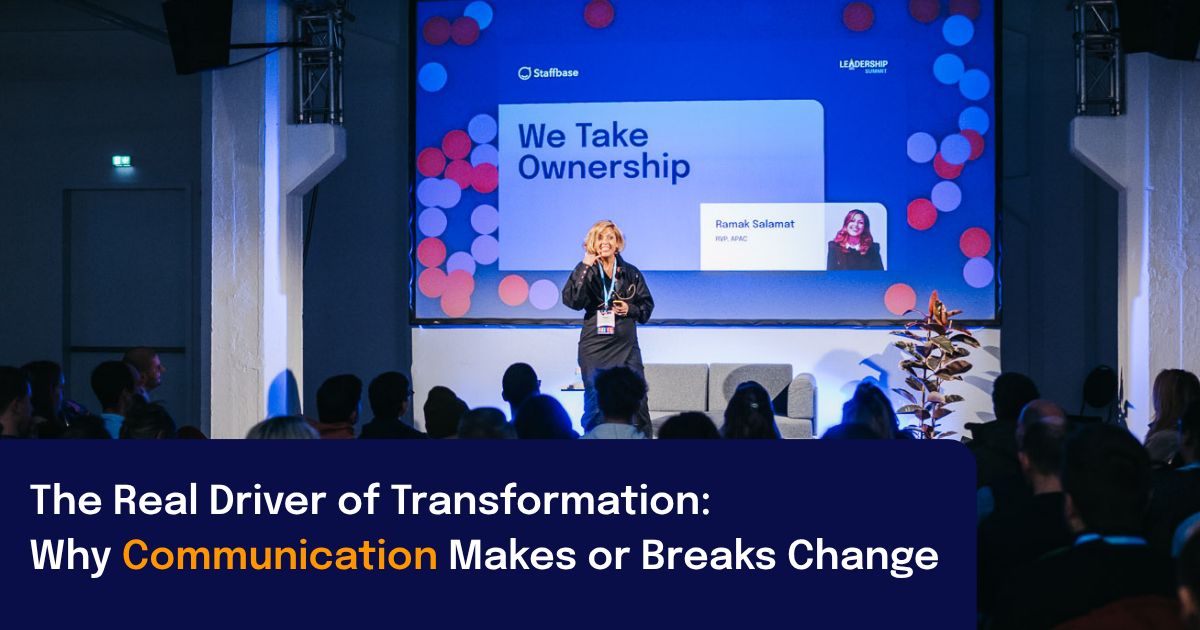Right after they took center stage at VOICES 2023, which brought together a total of more than 2,000 communications professionals in New York City and Berlin, Staffbase CEO Martin Böhringer and Global Director of Strategy Lara Dobson took the time to discuss recent developments in their multi-channel comms platform and the growing importance of digital employee communications.
In particular, the two discussed a new vision for the employee survey and the emerging role of AI in internal comms. It was a conversation clearly focused on the future and the important role internal communicators play, in the words of Böhringer, “to uncover the new narratives that paint a positive vision of the future and motivate people to strive to attain it.”
Hi Martin and Lara, it’s great to have you both here. We’ve got a lot to talk about, so let’s get started. Last year at VOICES 2022, Staffbase introduced its full multi-channel comms platform. Can you share how the response has been?
Martin Böhringer: Absolutely. The response to our multi-channel comms platform has been fantastic. Analysts like Forrester and Gartner recognized the importance of multi-channel capabilities in comms software, and our platform has been leading the way in this area. We’ve seen a strong uptake in multi-channel comms customers, which indicates that it’s a rapidly growing segment.
Lara Dobson: The numbers speak for themselves. Since introducing the multi-channel comms platform, we’ve witnessed a 311% increase in the adoption of a multi-channel approach among our customer base. The idea of breaking down siloes, consolidating tools, and working more efficiently across channels aligns with the direction the industry is heading. Today, strategic communicators need a unified platform to drive impactful communication.
Let’s talk about some of the new product features. Staffbase recently introduced Smart Surveys. Can you explain what they are and how they differ from traditional employee surveys?
Lara: Smart Surveys are embedded automatically into articles that utilize Smart Campaigns. They repeatedly ask the same question over time to track changes in employee attitudes. The data collected from these surveys is then aggregated in the Smart Insights dashboard, providing communicators with valuable analytics.
Martin: Our goal with Smart Surveys is to make the impact of comms visible. To achieve this, we need to measure alignment along the way. These surveys focus on specific comms goals and measure the audience’s alignment with those goals. As Lara says, they are shorter and more frequent, allowing for better tracking of progress over time.
That sounds like a tool that will benefit both communicators and employees. In your keynote at VOICES 2023, you mentioned that “clicks and likes are no longer enough” and that communicators must now demonstrate the ability to move “hearts and minds.” Can you elaborate on how they can achieve this?
Lara: To move hearts and minds through communication, strategic thinking is crucial. We need to move away from simply pushing information out there and focus on developing long-term strategies that help companies achieve their transformation goals. Long-term strategies are executed through campaigns, and measuring impact at an aggregated level becomes the natural next step.
Martin: Consider one of the biggest challenges today: accepting the need for change. Initially, people are often resistant to change and prefer things to stay the same. But once we understand the reasons behind the need for change and become inspired by the vision of a better future that we can help create, our perspective shifts. Creating clarity and alignment is a key goal of communication. In other words, helping people reach a place of understanding and inspiration is a vital communication task.
I like the idea that part of the communicator’s role is to inspire positive change. It seems related to how the 2023 Edelman Trust Barometer revealed that business is now the only institution seen as competent and ethical. How can companies maintain and build trust in such challenging times?
Martin: Business leaders should understand that trust is based on authenticity and proximity. Employees, in particular, have a closer relationship with their employers. They know their colleagues as individuals and have a deeper understanding of the inner workings of the business. Companies become credible sources because employees can verify the information coming from their workplace more easily than from other media outlets. To maintain that trust, companies must prioritize authenticity and avoid misusing that trust. In other words, they need to be truthful in their communication.
Lara: Owning communication channels is vital for building and preserving trust. Our customers have observed that having branded internal company channels provides a single source of truth for employees, where communication is authentic and encourages open discussion. Companies that establish these trusted channels can maintain and strengthen trust among their employees.
The Edelman Trust Barometer also highlighted that “CEOs are obligated to improve economic optimism and hold divisive forces accountable.” How does communication play a role in meeting this responsibility?
Lara: In mainstream media, divisive stories can be told without accountability for their polarizing impacts. However, companies have a different task: they must unite people to work together towards common goals. Communication is the most powerful tool CEOs have to shape the narrative and mobilize people toward a next-generation economy. Communication creates narratives, and narratives have a significant influence on attitudes, beliefs, and ultimately, events.
Martin: Absolutely. We humans are happier and more energized when we have a positive vision of the future. With multiple crises happening simultaneously, it’s sometimes challenging to see that positive vision. Take climate change, for example. How can we transition away from cheap, oil-based energy without compromising our standard of living? Companies are at the forefront of finding answers to these difficult questions, and it’s their responsibility to craft narratives that paint a positive vision of the future and inspire people to strive for it.
That’s a powerful role for communicators to play. What about AI chatbots like ChatGPT in business communication? What challenges do they pose, and does Staffbase have any plans to integrate them into its platform?
Lara: Generative AI presents both challenges and opportunities for business communicators. On one hand, it poses a threat to authenticity and can increase the noise in communication. On the other hand, it has the potential to help communicators streamline mundane tasks, allowing them to focus on more impactful work.
At Staffbase, we recognize the importance of using AI effectively. We recently introduced Staffbase Companion, our generative AI-based tool designed specifically for communicators. It helps them create titles, teasers, optimize texts based on best practices, and write summaries. We are intentional about choosing use cases for AI that benefit communicators directly. Rather than simply integrating ChatGPT into our platform, we aim to develop AI-powered features with a high level of intentionality.
Martin: AI brings a productivity boost for everyone involved in creating text and other forms of media, including business communication. This is a positive development that saves people a significant amount of time. In addition to Staffbase Companion, we will continue to explore how AI can support communicators in various ways. However, we must also address the challenges AI poses, especially the threat to authenticity. Trusted communication channels will play a critical role in an AI-influenced future.
I’m glad to hear you have a plan for using AI responsibly and with a clear purpose. Lastly, what do you think is the greatest barrier to change in most companies today, and how can it be overcome?
Martin: In most cases, the greatest barrier to change is the people within the organization. We tend to resist change, especially when we’re comfortable with the status quo. It’s the responsibility of those who envision the future, those who look ahead two, five, or ten years from now, to explain what they see and convince others that change is inevitable and essential for survival.
The good news is that moments of change often have positive consequences. Leaders need to show the way forward and inspire people to join them on the journey.
Lara: At Staffbase, we firmly believe that communication moves people, and people move companies. The answer lies in those words. The biggest barrier to change within any company is the company itself. Plans, systems, and strategies can be in place, but if people don’t buy in and actively participate, the change efforts will fail. Effective communication is the key to breaking through barriers and engaging people in the change process. Companies in need of change must prioritize and improve their communication practices.





